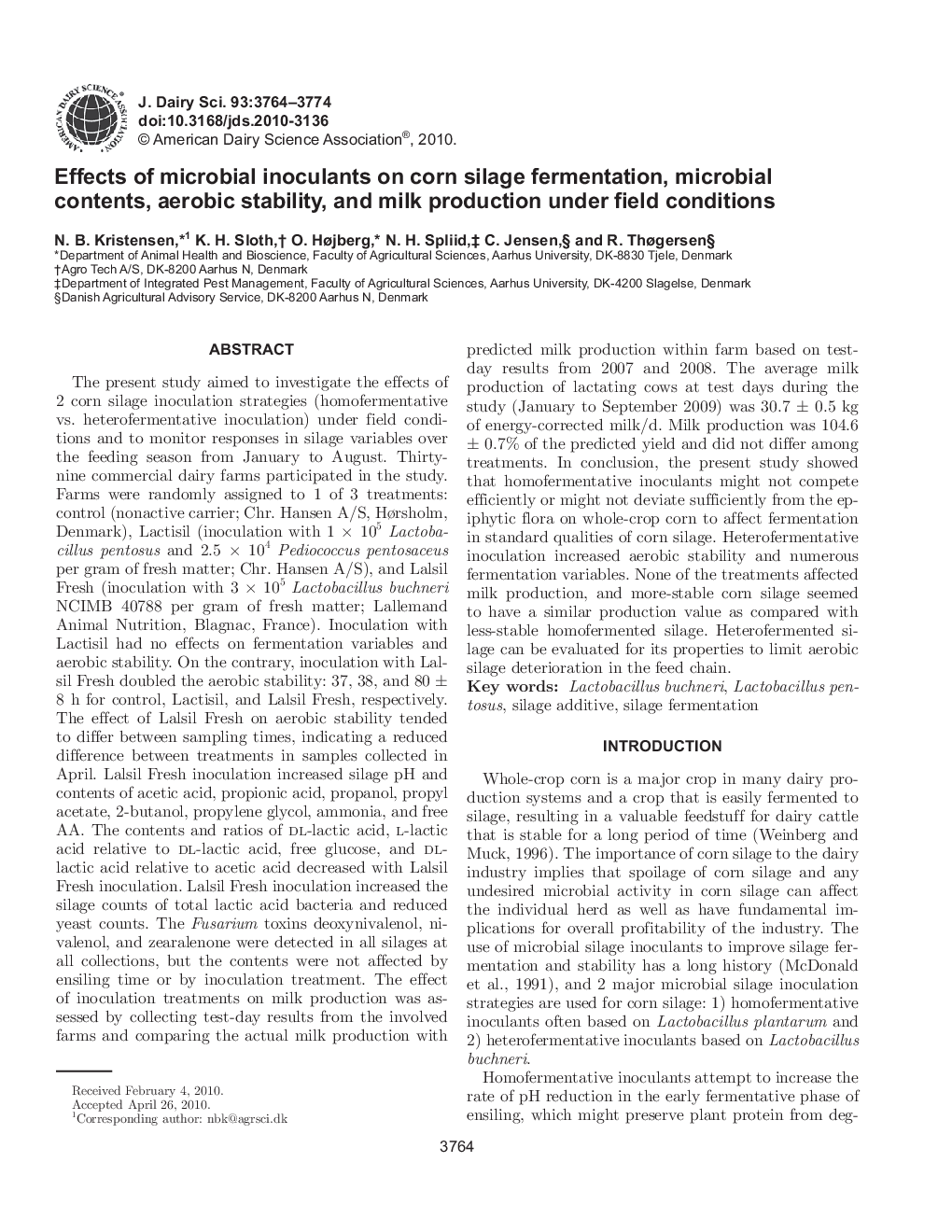| کد مقاله | کد نشریه | سال انتشار | مقاله انگلیسی | نسخه تمام متن |
|---|---|---|---|---|
| 10980952 | 1108073 | 2010 | 11 صفحه PDF | دانلود رایگان |
عنوان انگلیسی مقاله ISI
Effects of microbial inoculants on corn silage fermentation, microbial contents, aerobic stability, and milk production under field conditions
دانلود مقاله + سفارش ترجمه
دانلود مقاله ISI انگلیسی
رایگان برای ایرانیان
کلمات کلیدی
موضوعات مرتبط
علوم زیستی و بیوفناوری
علوم کشاورزی و بیولوژیک
علوم دامی و جانورشناسی
پیش نمایش صفحه اول مقاله

چکیده انگلیسی
The present study aimed to investigate the effects of 2 corn silage inoculation strategies (homofermentative vs. heterofermentative inoculation) under field conditions and to monitor responses in silage variables over the feeding season from January to August. Thirty-nine commercial dairy farms participated in the study. Farms were randomly assigned to 1 of 3 treatments: control (nonactive carrier; Chr. Hansen A/S, Hørsholm, Denmark), Lactisil (inoculation with 1 à 105Lactobacillus pentosus and 2.5 à 104Pediococcus pentosaceus per gram of fresh matter; Chr. Hansen A/S), and Lalsil Fresh (inoculation with 3 à 105Lactobacillus buchneri NCIMB 40788 per gram of fresh matter; Lallemand Animal Nutrition, Blagnac, France). Inoculation with Lactisil had no effects on fermentation variables and aerobic stability. On the contrary, inoculation with Lalsil Fresh doubled the aerobic stability: 37, 38, and 80 ± 8 h for control, Lactisil, and Lalsil Fresh, respectively. The effect of Lalsil Fresh on aerobic stability tended to differ between sampling times, indicating a reduced difference between treatments in samples collected in April. Lalsil Fresh inoculation increased silage pH and contents of acetic acid, propionic acid, propanol, propyl acetate, 2-butanol, propylene glycol, ammonia, and free AA. The contents and ratios of dl-lactic acid, l-lactic acid relative to dl-lactic acid, free glucose, and dl-lactic acid relative to acetic acid decreased with Lalsil Fresh inoculation. Lalsil Fresh inoculation increased the silage counts of total lactic acid bacteria and reduced yeast counts. The Fusarium toxins deoxynivalenol, nivalenol, and zearalenone were detected in all silages at all collections, but the contents were not affected by ensiling time or by inoculation treatment. The effect of inoculation treatments on milk production was assessed by collecting test-day results from the involved farms and comparing the actual milk production with predicted milk production within farm based on test-day results from 2007 and 2008. The average milk production of lactating cows at test days during the study (January to September 2009) was 30.7 ± 0.5 kg of energy-corrected milk/d. Milk production was 104.6 ± 0.7% of the predicted yield and did not differ among treatments. In conclusion, the present study showed that homofermentative inoculants might not compete efficiently or might not deviate sufficiently from the epiphytic flora on whole-crop corn to affect fermentation in standard qualities of corn silage. Heterofermentative inoculation increased aerobic stability and numerous fermentation variables. None of the treatments affected milk production, and more-stable corn silage seemed to have a similar production value as compared with less-stable homofermented silage. Heterofermented silage can be evaluated for its properties to limit aerobic silage deterioration in the feed chain.
ناشر
Database: Elsevier - ScienceDirect (ساینس دایرکت)
Journal: Journal of Dairy Science - Volume 93, Issue 8, August 2010, Pages 3764-3774
Journal: Journal of Dairy Science - Volume 93, Issue 8, August 2010, Pages 3764-3774
نویسندگان
N.B. Kristensen, K.H. Sloth, O. Højberg, N.H. Spliid, C. Jensen, R. Thøgersen,